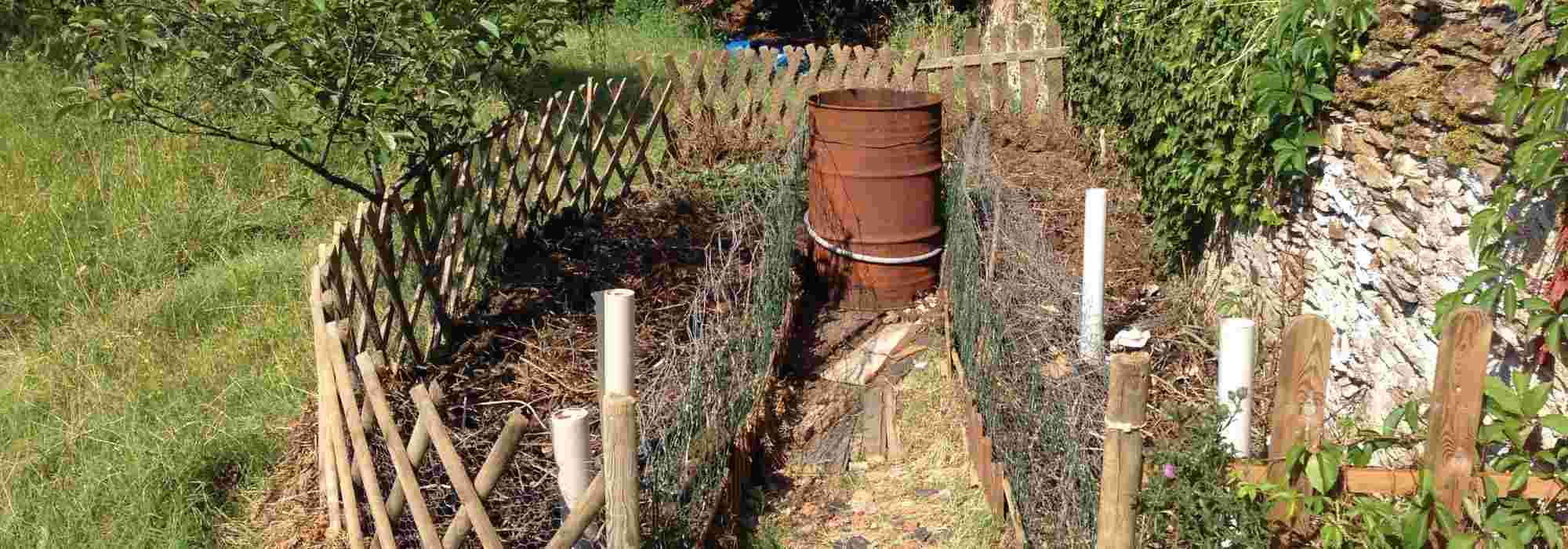
Keyhole garden
Discover this concept of integrated gardening and composting developed in Africa in the 1980s
Contents
Behind this name, which undeniably piques curiosity, lies a circular vegetable garden concept built around a composting column. Literally called a Keyhole garden, this keyhole garden is a nourishing, highly productive and nearly self-sufficient garden, drawing on some of permaculture’s principles. Raised and compact, it also has the advantage of being constructed from recycled materials. Sometimes called a solar garden, the keyhole garden also enables harvesting fine vegetables, even on poor or infertile soil. In short, this Keyhole garden has all the makings of a revolution. So let’s cast an eye through the keyhole to understand everything about this exceptionally productive vegetable garden: where and how to install it? How to build it? Which vegetables to plant? What advantages (and disadvantages) can be expected?
A brief history to begin with
The concept of keyhole garden was trialled and developed from 1988 by charity Send a Cow in Africa’s poorest countries. With aim to enable communities to feed their families by cultivating land. Through these keyhole gardens, families learned to favour the most nutritious crops, grown according to principles of organic agriculture. Highly suited to arid medium with poor soils, the keyhole garden, installed as close as possible to dwellings, enabled thousands of families to survive.
Twenty years later in France the urban edible gardening movement Les Incroyables comestibles was born. Citizen gardeners adopted this concept; keyhole garden caught on and began appearing in towns. So why not you?
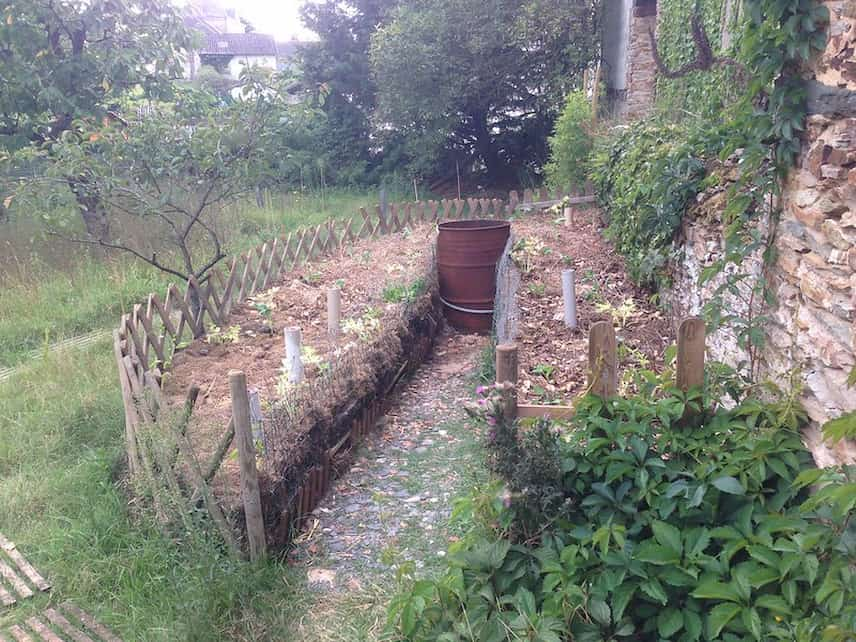
Keyhole garden requires little space
What exactly is a keyhole garden?
A keyhole garden is a small round vegetable patch about 3 metres in diameter and 60 cm to 1 metre high. Built of stone, reclaimed bricks or pallet wood, it requires no masonry work. At centre stands a composting tower 50 cm in diameter accessed via a small « path ». This integrated composter diffuses by percolation nutrients essential to vegetable growth. It should therefore be made from a permeable material such as bundles of wood, wire mesh, bamboo… This configuration resembles a keyhole, hence the name keyhole garden. Its raised height makes this vegetable patch accessible to elderly people and to those with disabilities.
Completely independent of soil, this mini-vegetable patch is highly productive because continuously fed with nutrients from the central composter, and water-efficient. Around this column where food waste is deposited, substrate, usually built in lasagna layers, allows to grow vegetables, soft fruit and aromatic plants in abundance.
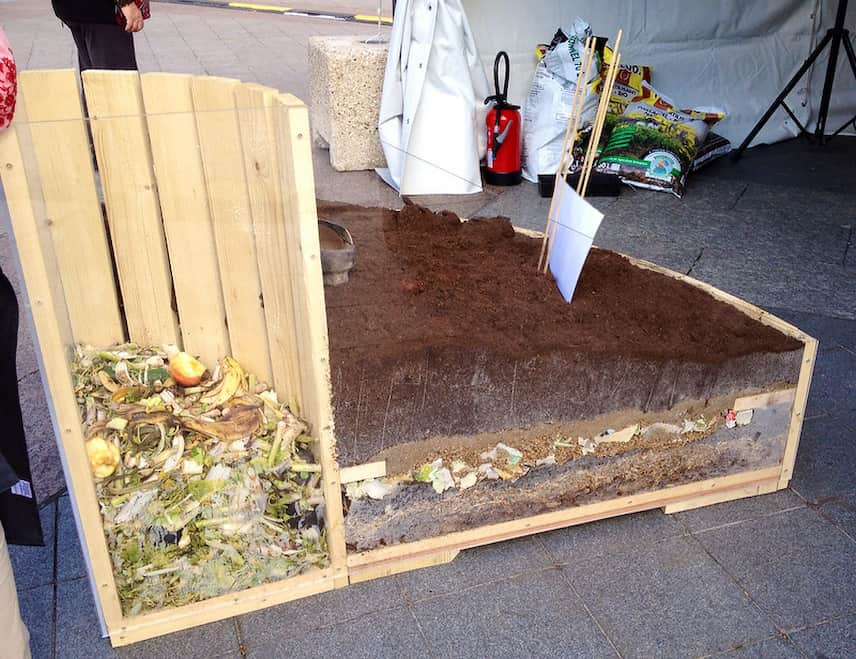
Central composter feeds substrate with nutrients
Watering or moistening chimneys can supplement the installation. In regions with a humid climate, they are not necessary.
Ideally, in Africa, the keyhole garden is placed near dwellings. To be able to feed it regularly with organic waste, do not place it too far from your home. Likewise, position it so that keyhole (= composter) faces East or North.
How to make a keyhole garden?
Nothing very complicated in setting up a keyhole garden that, ideally, is made from reclaimed materials. Expect around ten hours’ work if you are working alone.
- Start by marking out on the ground or delimiting with pegs the perimeter of about 3 m for your garden. Remember path and central 80 cm circle for compost bin.
- Build the walls of your keyhole garden either with wood pallets, placed vertically and fastened together with screws, or with dry-stone, terracotta tiles, or bricks stacked on top of each other. To ensure the structure holds, build it like an igloo, creating a slight vaulted effect.
- Make the central composting tower using stakes, simple wire mesh, or woven twigs.
- Construct any hydration chimneys, which also serve as ventilation, using branches, bamboo, or reclaimed pipes that you will drill with holes along their length.
- Fill your garden with substrate. Use the lasagne method, which consists of layering different ingredients: stones for drainage, dead wood, then branches, manure, garden soil, straw, a little wood ash, fresh leaves, grass clippings, compost… Each layer plays a role by supplying nitrogen, phosphorus, attracting insects and earthworms, and encouraging beneficial fungi to develop.
- Fill any remaining holes in the structure with wood boards or pieces of stone.
All that’s left is to feed your composter and plant your vegetables!
Read also
Lasagna gardeningWhat to plant in a keyhole garden?
In principle, all vegetables and aromatic plants can be planted in a keyhole garden, provided you avoid vegetable plants that grow too tall because of the relative height of the low wall.
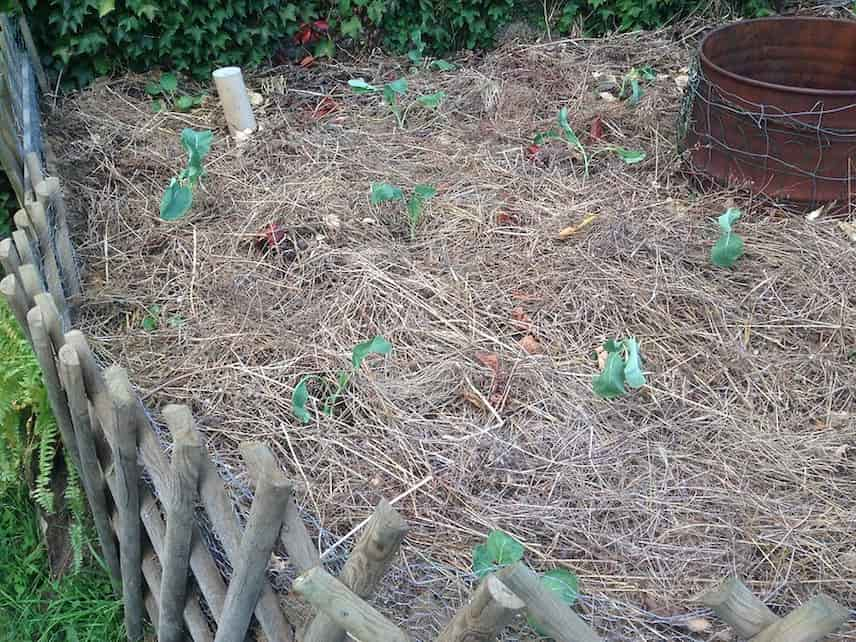
It may be wise to organise crops according to exposure and compost input. Thus, at edge of the structure, plant vegetables least demanding in nutrients and watering, such as broad beans, turnips, radishes, beans… And, in centre, closest to composting tower, place those that are greedy for moisture and organic matter, such as aubergines, melons, cardoons…
Tomatoes, peppers, courgettes and melons should be placed on south side, and salads on the other side, more in shade.
Also consider placing the most invasive vegetable plants or those that tend to spread near the edge.
When planting, remember to add a little potting compost into planting hole.
Caring for a keyhole garden
-
Continuous feeding of the central compost bin: The keyhole garden is designed around a central compost bin that supplies the garden with nutrients. Add compostable organic matter, such as kitchen scraps and garden waste, to this compost bin regularly throughout the year.
- As in any garden, crop rotation is important to prevent nutrient depletion and the emergence of plant-specific diseases. Try changing the position of different types of plants each year.
- At the end of each growth season, add organic matter, such as compost or manure, to your garden to help replenish soil nutrients.
-
Finally, check the integrity of your keyhole garden’s structure regularly. If necessary, repair or replace any materials that are damaged or worn.
Benefits of a keyhole garden
There are many advantages to building a keyhole garden. Some seem obvious, others more uncertain:
- Household waste is recycled by being kept as close as possible to the garden. This avoids handling and therefore effort since the growing area is adjacent to the composting area.
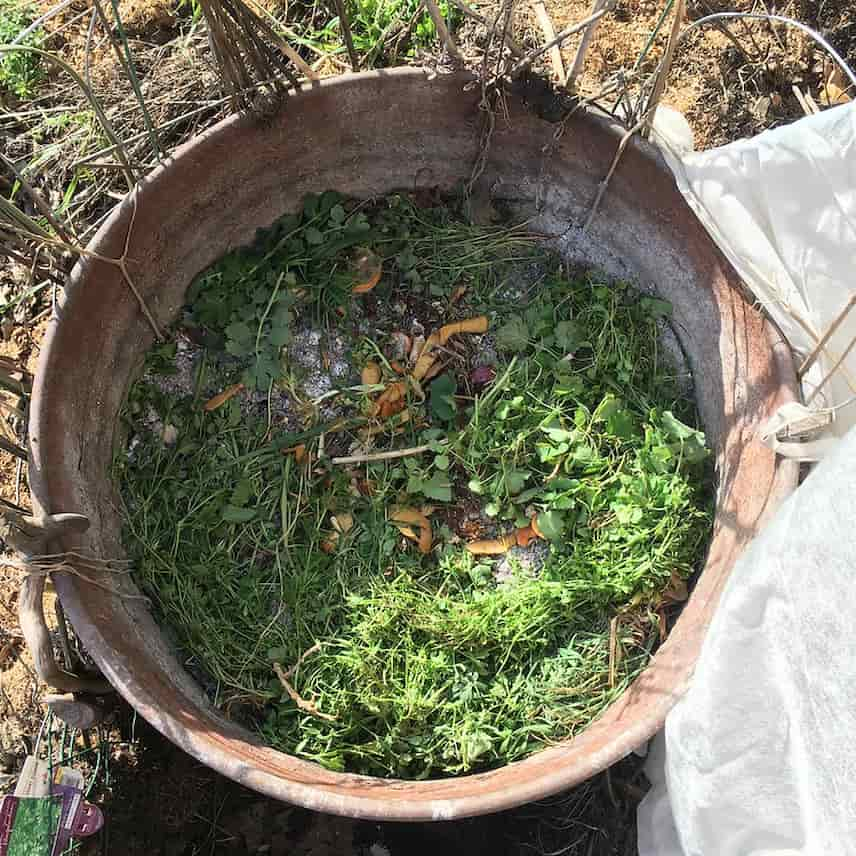
The compost silo is located at the centre of the keyhole garden
- Very easy to to grow since it is raised. Likewise, digging, hoeing and weeding are unnecessary. No more backache and tools are reduced to a minimum.
- The keyhole garden frees you from poor soil. It can be built on very poor, infertile soil, on a short grass meadow, or even on a concrete slab.
- It helps preserve biodiversity since beneficial insects can pass through unmortared materials. Among them, earthworms move from the compost into the growing substrate.
- Germination and growth of vegetable plants are favoured by heat, stored by construction materials and released during the night. Level of thermal inertia varies according to materials used. This type of structure therefore favours spring crops. Likewise, nutrients feed vegetable plants directly.
- Water for irrigation is saved because hydration chimneys capture rainwater or morning dew. In addition, the planting substrate retains water. Thus, a keyhole garden is self-sufficient in water.
- It requires little space and can be installed anywhere, even in a very confined area.
- It is particularly attractive, especially when built in fine dry stone. You can reuse leftover building materials and create harmony with your home. Moreover, this keyhole garden can also accommodate some melliferous or repellent flowers.
(A few) drawbacks...
The main drawback certainly lies in the size of the composter. Because of its small dimensions, the amount of organic waste will be limited. In addition, nothing is provided for collecting mature compost. To remedy this, it is possible to make a hole at the base of the composting silo beside the access path — a hole that can simply be closed with a large stone.
If stones or bricks warm the substrate in spring, in summer it may dry out. It will therefore require abundant watering. Originally, in Africa, keyhole gardens are watered with dishwater. In our regions, use of detergents or presence of a dishwasher prevents us from using this watering method. Why not plan a drip irrigation system, easy to install thanks to the garden’s circular shape?
Finally, gardeners who practise composting know how much slugs appreciate it. In a keyhole garden, compost and tender salad leaves are within reach of their voracious appetite. So one must hope that ground beetles, one of the main predators of slugs, also make use of this small gardening space.
- Subscribe!
- Contents
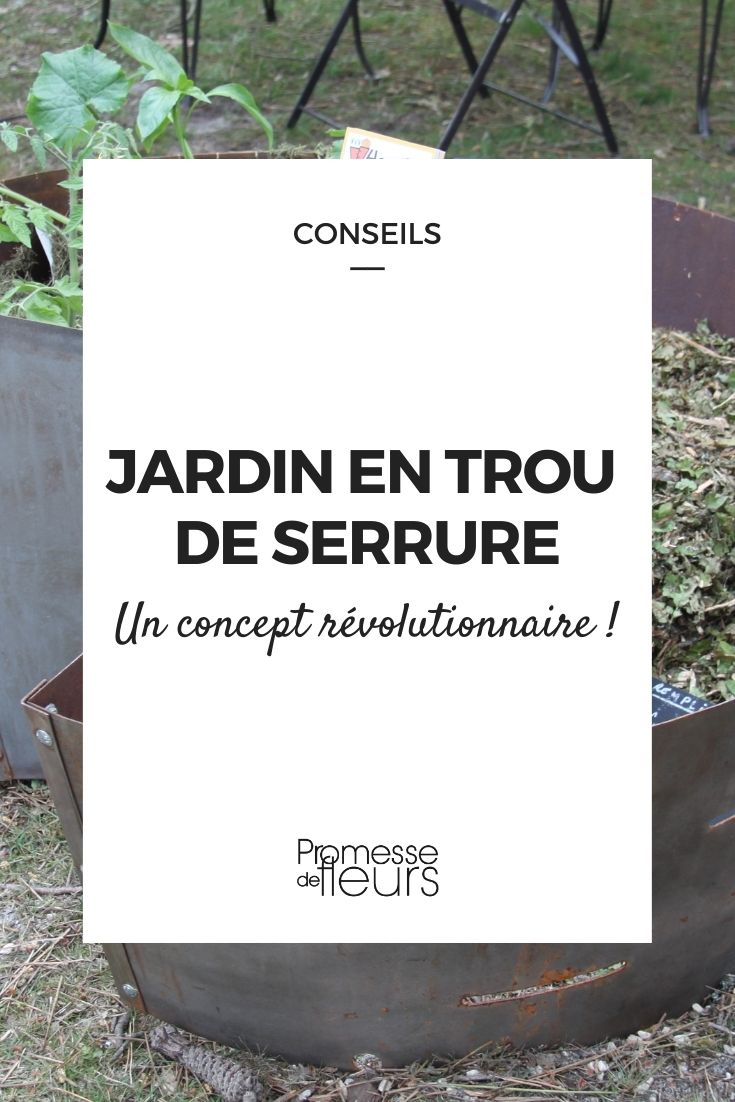































Comments